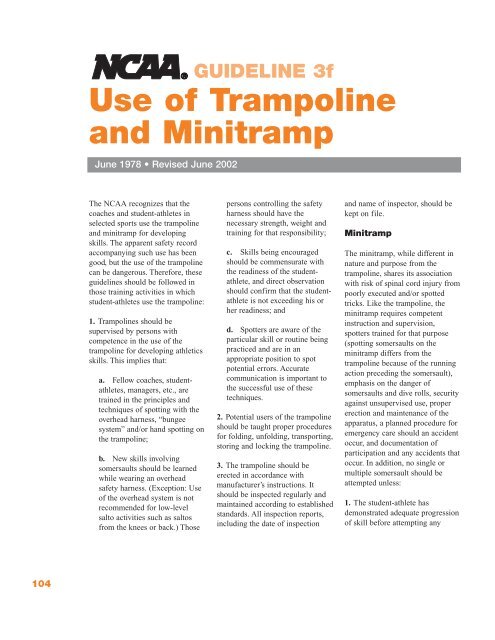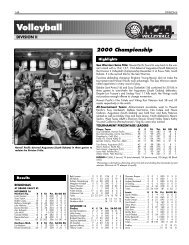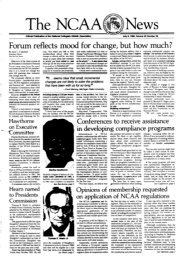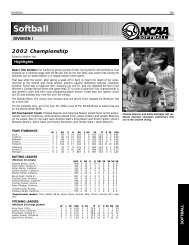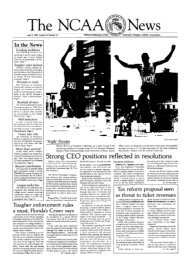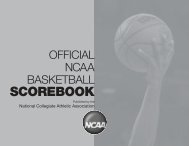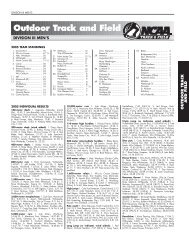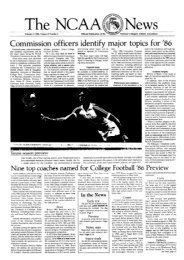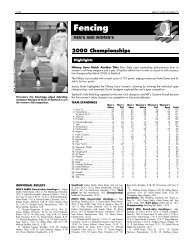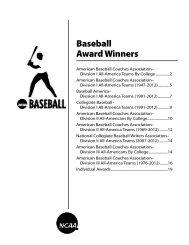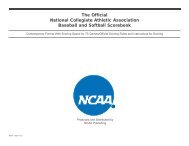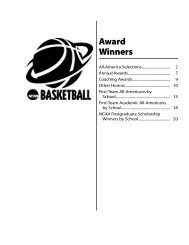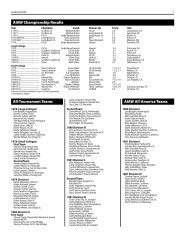Sports Medicine Handbook - NCAA
Sports Medicine Handbook - NCAA
Sports Medicine Handbook - NCAA
You also want an ePaper? Increase the reach of your titles
YUMPU automatically turns print PDFs into web optimized ePapers that Google loves.
104<br />
Use of Trampoline<br />
and Minitramp<br />
June 1978 • Revised June 2002<br />
The <strong>NCAA</strong> recognizes that the<br />
coaches and student-athletes in<br />
selected sports use the trampoline<br />
and minitramp for developing<br />
skills. The apparent safety record<br />
accompanying such use has been<br />
good, but the use of the trampoline<br />
can be dangerous. Therefore, these<br />
guidelines should be followed in<br />
those training activities in which<br />
student-athletes use the trampoline:<br />
1. Trampolines should be<br />
supervised by persons with<br />
competence in the use of the<br />
trampoline for developing athletics<br />
skills. This implies that:<br />
a. Fellow coaches, studentathletes,<br />
managers, etc., are<br />
trained in the principles and<br />
techniques of spotting with the<br />
overhead harness, “bungee<br />
system” and/or hand spotting on<br />
the trampoline;<br />
b. New skills involving<br />
somersaults should be learned<br />
while wearing an overhead<br />
safety harness. (Exception: Use<br />
of the overhead system is not<br />
recommended for low-level<br />
salto activities such as saltos<br />
from the knees or back.) Those<br />
GUIDELINE 3f<br />
persons controlling the safety<br />
harness should have the<br />
necessary strength, weight and<br />
training for that responsibility;<br />
c. Skills being encouraged<br />
should be commensurate with<br />
the readiness of the studentathlete,<br />
and direct observation<br />
should confirm that the studentathlete<br />
is not exceeding his or<br />
her readiness; and<br />
d. Spotters are aware of the<br />
particular skill or routine being<br />
practiced and are in an<br />
appropriate position to spot<br />
potential errors. Accurate<br />
communication is important to<br />
the successful use of these<br />
techniques.<br />
2. Potential users of the trampoline<br />
should be taught proper procedures<br />
for folding, unfolding, transporting,<br />
storing and locking the trampoline.<br />
3. The trampoline should be<br />
erected in accordance with<br />
manufacturer’s instructions. It<br />
should be inspected regularly and<br />
maintained according to established<br />
standards. All inspection reports,<br />
including the date of inspection<br />
and name of inspector, should be<br />
kept on file.<br />
Minitramp<br />
The minitramp, while different in<br />
nature and purpose from the<br />
trampoline, shares its association<br />
with risk of spinal cord injury from<br />
poorly executed and/or spotted<br />
tricks. Like the trampoline, the<br />
minitramp requires competent<br />
instruction and supervision,<br />
spotters trained for that purpose<br />
(spotting somersaults on the<br />
minitramp differs from the<br />
trampoline because of the running<br />
action preceding the somersault),<br />
emphasis on the danger of<br />
somersaults and dive rolls, security<br />
against unsupervised use, proper<br />
erection and maintenance of the<br />
apparatus, a planned procedure for<br />
emergency care should an accident<br />
occur, and documentation of<br />
participation and any accidents that<br />
occur. In addition, no single or<br />
multiple somersault should be<br />
attempted unless:<br />
1. The student-athlete has<br />
demonstrated adequate progression<br />
of skill before attempting any


